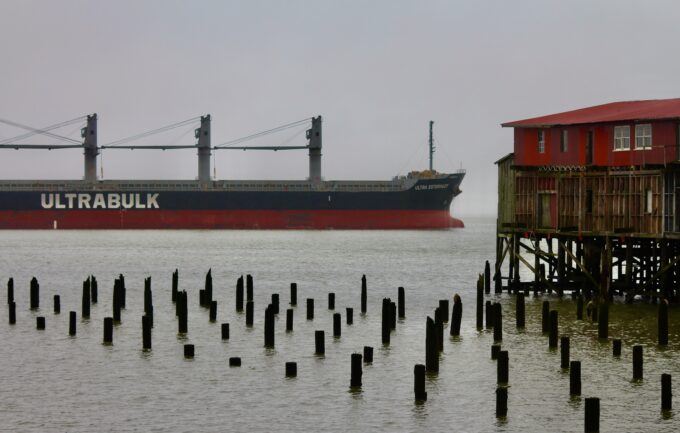
Ultrabulk cargo ship, Astoria, Oregon. Photo: Jeffrey St. Clair.
It is perhaps a wonder that it was not until experiencing the fallout from a global pandemic, that most Americans were forced to read or hear the words ‘supply chain’ or ‘logistics.’ Surprising both because it is on these things that the basic essentials of modern life are dependent and because of the revolutionary changes in these arenas over the past generation. Yet with COVID still haunting the global economy, as of this writing China is only just emerging from the largest COVID lockdown since Wuhan, and with inflation at the highest it’s been in decades, uncertainty about supply chains lingers.
Over the past twelve months this uncertainty has assumed many forms. There have been reports of shutdowns of factories in Asia, with workers reluctant to return to their jobs, ships backed up by the dozen at American ports, a shortage of truck drivers, and exploding wealth for the likes of Jeff Bezos. Obviously, the immediate trigger to the crisis would appear to be a mix of COVID and as a result Americans greatly increasing their online shopping. According to U.S. Census Bureau data, e-commerce sales jumped nearly 32 percent in 2020, and 50.5 percent since 2019. Overall, online sales now account for 19 percent of retail. Given the $400 billion in government stimulus and much of the outdoor service economy locked down (i.e. restaurants, movies, sports events, etc.), Americans spent nearly $1 trillion more in goods in 2021 compared to pre-pandemic times. Hard to see any supply chain not getting strained. Still, in May 2022 only 11 percent of shipments from Asia arrived in North America on time, down from 59 percent in May 2020.
By the end of 2021 the cost of shipping from Asia to the west coast of the U.S. had risen 330 percent in one year. According to the Freightos Baltic Index, as of June 22nd the average global price to ship a 40-foot container was $7261, down from a peak of over $11,000 in September 2021, but still five times higher than before the pandemic. The United Nations Conference on Trade and Development (UNCTAD) estimated that higher shipping rates during the lockdown raised the inflation rate by 1.5 percent.
Step back further though and a fuller picture emerges, one featuring globalization, exploitation, and deindustrialization. It is no secret that the U.S. has lost millions of manufacturing jobs over the past generation- about 7.5 million since 1980. While automation has been a big factor in the decline, so has outsourcing and subcontracting. From 1970 to 2010 the number of manufacturing jobs in East Asia more than tripled from 31 million to 97 million. In the decade from 1997 to 2007 value of East Asian exports increased from $269 billion to nearly $1.5 trillion. Of course, the emergence of China as the world’s factory played a vital role. Foreign direct investment into China increased from $57 million in 1980 to $114.7 billion in 2010. Imports from China reached $506 billion in 2021 (with $151 billion in exports headed the other way, a trade deficit of $355 billion). Imports from Vietnam have also exploded over the past two decades. In 2020, Vietnam was the 6th largest supplier of U.S. imports, up 21.2 percent from just 2019, and 436 percent from 2010. In a way, Vietnam has been the winner of the U.S. trade war with China. The U.S. trade deficit with Vietnam exploded nearly threefold to $90 billion since 2018 (as for the effectiveness of the U.S. tariffs: a good amount of the exports from Vietnam originate in Chinese-owned factories). Indonesia imports are up 23 percent since 2010.
Nothing exemplifies the supply chain crisis quite like the sight of cargo ships backed up by the dozens outside the Ports of Los Angeles and Long Beach. Containerships transport 90 percent of global trade and these two ports handle about 40 percent of U.S. imports. A ship from China takes 15-20 day journey to an American port. The process of turning a ship around from China to the U.S. typically takes around 60 days. The process is supposed to be timed for maximum efficiency, one ship in, one out. COVID fouled up the system. At peak chaos there were over 100 ships waiting to dock. If all the waiting containers had been laid out the line would actually have stretched from Los Angeles to Chicago. The turnover time increased to 100 days. Biden eventually ordered the ports to work 24/7 and some ships were diverted to other ports. Ships waiting outside the LA ports fell by half by the beginning of 2022, though this spring a dozen plus ships were often backed up at ports around the U.S. As of May nearly 20 percent of container vessels globally were still waiting outside congested ports, including hundreds in China.
In a perfectly surreal example of built-in absurdity, the price hike made a trip from Asia to the U.S. 20 times more expensive than a trip going the other way. Therefore through the pandemic there were reports of ships returning to Asia with many of their containers empty. The shippers have been rejecting U.S. agricultural exports. It is more profitable to simply return to Asia and refill there rather than wait for food to be loaded and carried back. This past holiday season, some of the largest U.S. retailers were chartering their own, smaller ships to get around the backlog, docking at smaller ports around the country. Of course, this option was beyond the great majority of U.S. businesses.
If such a picture brings to mind any notions of incompetence or inefficiency, from the perspective of the shipping industry these can be quickly cast aside. In 2021 global shipping earnings equaled the entire industry’s earnings from the previous decade. Last November, the Wall Street Journal ran an article titled ‘For Investors in Shipping, Payoff at last.’ The opening lines read: ‘Global supply-chain bottlenecks are creating headaches for retailers, delays for consumers- and big gains for financial firms that invested in container ships before the pandemic upended the logistics business.’
The emergence of COVID has not been the only recent cause of disruption for the shipping supply chain. On March 23, 2021, the 20,124 TEU containership Ever Given ran aground in the Suez Cancel (TEU stands for Twenty-Foot Equivalent Unit, meaning the number of standardized 20-feet containers a ship can carry). The shortest shipping route between Europe and Asia, up to 15 percent of global trade passes through the Suez Canal, including a million barrels of oil a day and roughly 8 percent of the supply of liquefied natural gas. On a given day that means about 50 ships. With Ever Given wedged in the canal for a week, hundreds of ships were backed up in a 60-mile queue waiting to get through. All in all, an estimated $9.6 billion a day worth of trade was held up.
On March 15 2022, another ship owned by Evergreen Marine Corp, this one named Ever Forward, went aground in Chesapeake Bay. While this blockage did not stop traffic it took a month to free the ship. The ship CSCL Jupiter did hinder ship traffic when it ran aground for a day outside the port of Antwerp in 2017.
Given that navigational technology has improved in recent years ship groundings should be becoming less common. Yet there is the sheer size of the current ships. A few months after the Ever Given jam, the largest containership ever built, Ever Ace (another by the Evergreen Marine Corp), made its way through the Suez Canal in August 2021. Measuring just over 1300 feet (about the size of the Empire State Building) with a capacity of nearly 24,000 TEU (23,992 to be exact), Ever Ace took the title from the HMM Algeciras (23,964 TEU) which took its maiden voyage hardly a year earlier. Both ships are just part of expanding fleets of mega-ships of that size soon to be sailing.
For perspective, the largest ships today are 15 times what they were in the late 1960s around the time when containerization was standardized. The world’s first commercially successful container trip, Malcolm McLean’s coverted tanker, the Ideal-X, took 58 containers from New Jersey to Texas in 1956. When the ship Encounter Bay, one of the early fully cellular containerships, went into service in 1969 its capacity was 1578 TEUs. Even by the year 2000 ship capacity topped out at around 8000 TEUs. Then when the shipping company Maersk introduced its E-Series of ships in 2006, capacity reached around 15,000 TEUs, basically doubling the capacity of the previous largest ships. Since then over 130 ships have launched with a carrying capacity between 18,000 and 24,000 TEUs. In the past decade alone or so capacity has gone up 80 percent.
Here is where the deregulation comes in. As Matt Stroller described in a Substack piece, for most of the 20thcentury U.S. shipping law was based on the Shipping Act of 1916. The act granted shipping companies an exemption from anti-trust laws. They were allowed to form alliances with each other (something that continues today) where they would jointly set routes and prices. However there was a condition that all prices had to be public, service had to be offered on equal terms, and companies were not permitted to undermine competitors by offering volume discounts or under-the-table rebates. In addition to the Act, there were subsidies for shipbuilding and the Merchant Marine Act of 1920 (known as the Jones Act) which requires all ships carrying goods between two U.S. ports to be American-built, -owned, -crewed, and-flagged. The idea was to protect smaller companies and businesses against predatory moves of larger companies by giving bargaining power (hence the public prices). National security concerns wanted to keep American shipping strong. Stable prices take the edge off a boom-and-bust industry.
The system was tossed aside by the Ocean Shipping Reform Act of 1998. In a sense we were left the worst of all worlds: the anti-trust exemption was kept and the transparency was scrapped. Predictably, concentration in the industry exploded. Up to 60 of the 1000 largest ocean carriers have vanished since the early 2000s. Banks were only too eager to provide funding for the megaship arms-race. Shipping companies are good lending targets as valuable ships can simply be repossessed in the event of a default. Plus shipping often receives government subsidies.
In the midst of all this came the economic crash of 2008. The downturn meant there wasn’t enough freight to fill the growing ship capacity. With shipping prices at rock bottom the remaining large carriers formed alliances. The Top 10 shipping companies had 40 percent of the market in 1998. Today it is over 80 percent. All ten companies are part of one of the three company alliances that dominate the industry- 2M, Oceans Alliance, and The Alliance. The megaships also keep up a nice barrier to entry. New companies have a hard time breaking in with such upfront costs as a megaship. Infrastruture (railroads, ships, social media networks) tend to require a huge amount of investment to build, but not much to operate. This makes it inefficient for many companies to build competing networks. As a result it is often owned by the state of too-big-to-fail monopolies.
The larger the ship the more the shipping company is supposed to be able to squeeze out savings on construction, fuel, and staff. The larger the ships size to go with consolidation and alliance also give companies leverage over other parts of the system. This led to an arms race among the ports. Ports in Baltimore, Miami, and Norfolk began dredging projects to deepen their harbors. The Port Authority of New York and New Jersey spearheaded a project to raise the Bayonne Bridge 64 feet to accommodate larger ships. The project cost $1.7 billion. Such works are quite convenient for the carriers as they get almost all the savings while the ports, and the taxpayers that often contribute funding, foot the bill. As larger ships are unable to service as many ports as smaller ones, they lead increased concentration of terminal operators and therefore port traffic, one reason the Ports of Los Angeles and Long Beach handle so much traffic and are therefore prone to backups.
A few weeks ago, in the face of raising inflation, President Biden ranted about ‘foreigned owned’ shipping companies who raised their prices by ‘as much as 100 pecent.’ He chimed ‘Every now and then something you learned makes you viscerally angry.’ On June 16th, he signed the Ocean Shipping Reform Act of 2022. Legislation that breezes through Congress nowadays promises not to be too earthshattering. The act empowers the Federal Maritime Commission to limit ocean carriers refusing American and limit port fees. It is questionable how thoroughly it can be enforced.
Another facet to the shipping world is flags of convenience. For a fee ship owners can simply register their ships with a willing country. Countries without a nationality or residency requirement for ship registration are described as having open registry. This form of paper globalization works the same as other forms. The obvious goal is to take advantage of places with low wages and less regulation. Thus in 1960 the U.S. flag merchant fleet had almost 3000 ships. By 2019 the number was 182. Almost three-quarters of the worl’d fleet is now flagged under a country different from the ship owners. For a long time the places with the largest registries have been Panama, Liberia, and the Marshall Islands. In her book Ninety Percent of Everything, Rose George explains:
‘There are few industries as definitely opaque as shipping. Even offshore bankers have no developed a system as intricately elusive as the flag of convenience, under which ships can fly the flag of a state that has nothing to do with its owner, crew, or route.’
While the International Maritime Organization, a UN agency, has passed plenty of regulations since its inception, and the International Labor Organization (ILO) has adopted stadards for seafarers- the Maritime Labor Convention was ratified in 2006 by 80 countries and came into effect in 2013, the ocean has a tendancy to dissolve such paper. As with many things, the COVID pandemic brought the underbelly to light.
In September 2020, as 300,000 workers were stranded on ships, a Bloomberg report found dozens of labor violations. Of the 40 seafarers interviewed for the story, half didn’t have current contracts and others hadn’t been paid for months, meeting the ILO’s definition of forced labor. Shipping lines and staffing agencies (as in other industries such as meatpacking, shippers often outsource hiring to agencies), determine when and how workers return home, even holding their passports. In an industry rife with middlemen, including networks of owners, operators, and employmeny agencies, it is difficult to hold parties accountable.
By no means is shipping the only leg of the supply chain that is hellish for workers. In the U.S. when goods are unloaded from shipping containers they are moved onto truck beds. Trucks move around 70 percent of domestic goods, over ten billion tons of freight a year. Truck drivers’ wages have plummeted over the past four decades. If the adjusted average wage of a truck driver in 1980 was $110,000, by 2019 the trucker earned $45,000 a year- a decline of 60 percent. From there goods are often driven to warehouses. The turnover rate at Amazon warehouses can reach 150 percent a year. Buy commodities certified ‘Fair Trade’ as you will, just don’t assume such a concept applies to the workers that bring them to you.


